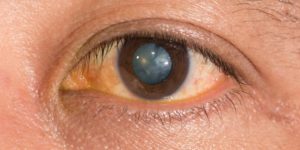Leber congenital amaurosis (LCA) is an eye disorder that primarily affects the retina. LCA is most typically passed through families by the autosomal recessive pattern of inheritance. In this type of inheritance, both parents, called carriers, have one gene for the disease paired with one normal gene. Each of their children has a 25 percent chance (or 1 chance in 4) of inheriting the two LCA genes (one from each parent) needed to cause the disorder. Carriers are unaffected because they have only one copy of the gene. At this time, it is impossible to determine who is a carrier for LCA until after the birth of an affected child.People with this condition typically have severe visual impairment beginning in infancy.
Signs or symptoms with this disease include:
Photophobia, involuntary movements of the eyes (nystagmus), and extreme farsightedness. The pupils also do not react normally to light. Additionally, the cornea may be cone-shaped and abnormally thin (keratoconus). Franceschetti’s oculo-digital sign is characteristic of Leber congenital amaurosis. This sign consists of poking, pressing, and rubbing the eyes with a knuckle or finger. Different subtypes have been described. The different subtypes are caused by genetic changes in different genes. Some of these subtypes are also distinguished by their patterns of vision loss and related eye abnormalities.
Leber congenital amaurosis (LCA) is a rare genetic eye disorder. Affected infants are often blind at birth. Other symptoms may include crossed eyes (strabismus); rapid, involuntary eye movements (nystagmus); unusual sensitivity to light (photophobia); clouding of the lenses of the eyes (cataracts); and/or a cone shape to the front of the eye (keratoconus). LCA is usually inherited as an autosomal recessive genetic condition. In addition, some infants may exhibit hearing loss, intellectual disability, and/or developmental delay.
Specific types of LCA have been defined based on the causative gene. Some types are associated with little change in vision over time (stationary disease) while others become more severe over time (progressive disease).
Causes
LCA is a monogenic disease and at least 27 genes are implicated. Changes (mutations) in these genes can account for about 80-90% of diagnosed cases of LCA. The genes responsible for the remaining 10-20% of diagnoses are not known. LCA is usually inherited as an autosomal recessive genetic condition. Twenty-four of the genes associated with LCA cause only recessive disease. Two genes (IMPDH1 and OTX2) are known to cause dominant disease. One gene (CRX) is known to cause either dominant or recessive disease, depending on the specific mutation.
Recessive genetic disorders occur when an individual inherits two copies of an abnormal gene for the same trait, one from each parent. If an individual receives one normal gene and one gene for the disease, the person will be a carrier for the disease but usually will not show symptoms. The risk for two carrier parents to both pass the defective gene and have an affected child is 25% with each pregnancy. The risk to have a child who is a carrier like the parents is 50% with each pregnancy. The chance for a child to receive normal genes from both parents and be genetically normal for that particular trait is 25%. The risk is the same for males and females.
There are about 20,000 different genes in a human and all individuals carry one copy of several abnormal genes. Parents who are close relatives (consanguineous) have a higher chance than unrelated parents to both carry the same abnormal gene, which increases the risk to have children with a recessive genetic disorder.
In rare cases, LCA is inherited as an autosomal dominant genetic disorder. Mutations in three genes, CRX, IMPDH1, and OTX2 are currently known to be associated with this type of LCA.
Dominant genetic disorders occur when only a single copy of an abnormal gene is necessary to cause a particular disease. The abnormal gene can be inherited from either parent or can be the result of a new mutation in the affected individual. The risk of passing the abnormal gene from affected parent to offspring is 50% for each pregnancy. The risk is the same for males and females.
Those affected populations with LCA:
The prevalence of LCA has been estimated to be 1-2/100,000 births. This disorder affects males and females in equal numbers.
Related Disorders



